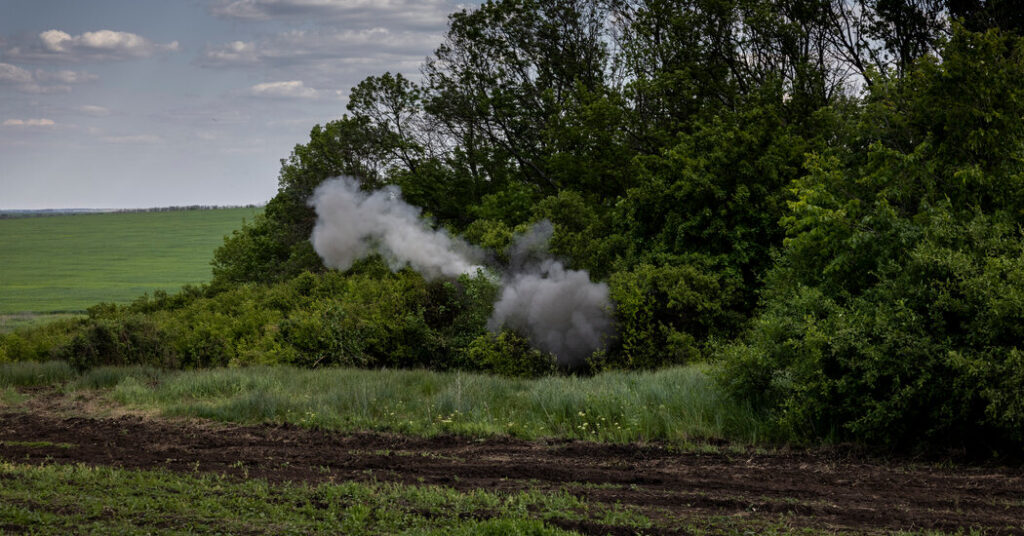Ukrainian soldiers fired artillery rockets containing antipersonnel land mines into a Russian-controlled area of eastern Ukraine last year in apparent violation of international agreements banning the use of such weapons, a leading human rights group said in a report released Friday.
The group, Human Rights Watch, called the mines “inherently indiscriminate weapons” because of their inability to distinguish enemy soldiers from noncombatants. It urged the Ukrainian government to “act on its expressed commitment not to use banned antipersonnel land mines, investigate the military’s use of these weapons, and hold those responsible to account.”
Human Rights Watch has issued several reports about land mine use by Russian and Ukrainian forces since Moscow’s full-scale invasion of Ukraine in February 2022. Russian troops have used at least 13 kinds of antipersonnel mines “in multiple areas across Ukraine” that have killed and injured civilians, according to the group.
The Ukrainian government promised to investigate the allegations against its soldiers during a June 21 meeting in Geneva of nations that have signed the treaty banning the use of the mines, the group said. Officials at Ukraine’s Defense Ministry in Kyiv and at its embassy in Washington did not immediately respond to a request for comment.
In 1997, more than 100 countries agreed not to use or maintain stockpiles of antipersonnel land mines, small explosive weapons that are typically buried just below the ground’s surface. When stepped on, they detonate with enough force to blow off a person’s leg.
Injuries from mines of this kind can also be fatal.
The International Campaign to Ban Landmines, which monitors treaty compliance and collects data on land mine contamination, said that in 2021 at least 5,544 people had been injured or killed by mines around the world. Most of those casualties were civilians, the report said, half of whom were children.
Ukraine signed the agreement, often called the Mine Ban Treaty, in 1999 and ratified it in 2005. The United States and Russia have refused to join the pact.
In 2014, the Obama administration affirmed a Clinton-era policy stating that the Pentagon would use antipersonnel mines only on the Korean Peninsula, but the Trump administration overturned that directive in 2020, citing a new focus on strategic competition with major powers. The Biden administration returned to the Obama-era policy in June 2022.
Russian and Ukrainian troops have also widely used anti-tank land mines, which are much larger than antipersonnel land mines and are typically designed to explode only when hundreds of pounds of pressure are applied — such as when a truck or an armored vehicle drives over one. These devices generally are not banned under international law.
In April, the Pentagon announced it was sending 1960s-era M21 anti-tank mines to Ukraine. Washington has also sent Ukraine more than 14,000 155-millimeter artillery shells called RAAMS, for Remote Anti-Armor Mine System, which break open midair and release nine small puck-like munitions that fall to the ground unguided. Each small mine contains a magnetic sensor that causes it to explode when a vehicle approaches and is designed to self-destruct after a couple days.
Human Rights Watch said it had recovered evidence in May from areas of eastern Ukraine formerly held by Russian troops indicating that Ukrainian soldiers had fired Russian-made artillery rockets there that each contained 312 small PFM-1 mines. Often referred to as a “butterfly” mine because of its shape, the PFM-1 is believed to be a copy of a mine used by U.S. troops in Vietnam that was made with a plastic case to make it more difficult to find with metal detectors.
Human Rights Watch said it had found 15 photos on social media posted last autumn showing Russian-made rockets bearing handwritten messages in Ukrainian, which the group said it believed were tied to two fund-raising efforts wherein donors could have a personal message written onto a weapon that would be fired at Russian forces.
Remnants of one rocket warhead that Human Rights Watch later discovered in mined areas bore the same message handwritten in Ukrainian.
The group has released a series of reports since the war began describing evidence of Russian behavior that it says constitutes war crimes. One published shortly after the invasion detailed instances of Russian troops raping and killing Ukrainian civilians and committing other instances of unlawful violence.

